|
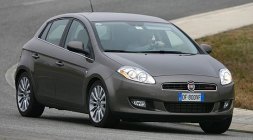 Fiat
launched Stilo in 2001 with high expectation. It was supposed to
challenge Volkswagen Golf seriously for class leading position, but
unfortunately, it turned out to be a big flop and, together with the
unpopular Punto Mk2, nearly dragged Fiat into bankruptcy. Stilo was
originally planned to survive until 2008, but its poor sales
performance meant Fiat had to bring forward its replacement to early
2007. This is the new Bravo. Fiat
launched Stilo in 2001 with high expectation. It was supposed to
challenge Volkswagen Golf seriously for class leading position, but
unfortunately, it turned out to be a big flop and, together with the
unpopular Punto Mk2, nearly dragged Fiat into bankruptcy. Stilo was
originally planned to survive until 2008, but its poor sales
performance meant Fiat had to bring forward its replacement to early
2007. This is the new Bravo.
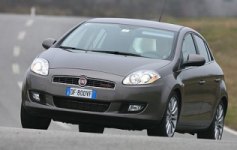 You
might remember the first generation Bravo from 1995-2001. It won
European Car of the Year Award and was quite successful commercially.
Perhaps want to recapture the same success, Fiat reuse the name Bravo
for the new car. Note that the old Bravo used to be a 3-door hatch (the
5-door version was Brava), but the new Bravo is a 5-door hatch and
won't be available in 3-door form. That is the main difference in their
layout. In terms of appearance, the new Bravo does have some
resemblance to the old one, especially the strong shoulders at the rear
end and the oval design of taillights. Of couse, the new design is more
contemporary. It looks like a larger Grande Punto (what about the term
"Jumbo Punto" ?), with a long front overhang to enable a sleek nose
without being compromised by the high bonnet (by the way, many cars
have their styling spoiled by pedestrian safety regulations). The
shoulder lines rise handsomely towards the high-set taillights to form
a sporty appearance. Well, the Frank Stephenson design is probably not
as brilliant as Giugiaro's Grande Punto, but in the field of D-segment
family cars, it is one of the best. You
might remember the first generation Bravo from 1995-2001. It won
European Car of the Year Award and was quite successful commercially.
Perhaps want to recapture the same success, Fiat reuse the name Bravo
for the new car. Note that the old Bravo used to be a 3-door hatch (the
5-door version was Brava), but the new Bravo is a 5-door hatch and
won't be available in 3-door form. That is the main difference in their
layout. In terms of appearance, the new Bravo does have some
resemblance to the old one, especially the strong shoulders at the rear
end and the oval design of taillights. Of couse, the new design is more
contemporary. It looks like a larger Grande Punto (what about the term
"Jumbo Punto" ?), with a long front overhang to enable a sleek nose
without being compromised by the high bonnet (by the way, many cars
have their styling spoiled by pedestrian safety regulations). The
shoulder lines rise handsomely towards the high-set taillights to form
a sporty appearance. Well, the Frank Stephenson design is probably not
as brilliant as Giugiaro's Grande Punto, but in the field of D-segment
family cars, it is one of the best.
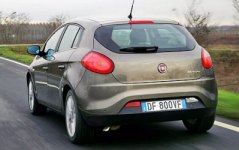 As
aforementioned, Fiat needed to bring forward the launch of the car by
more than one year. In addition to the conservative sales target at
120,000 units a year, the development must be quick and low cost. To do
that, Fiat engineered and tested the car digitally by computer
simulations and made small amount of prototypes only at the last stage.
This shortened the development time from design freeze to market launch
to only 18 months – should be a record for motor industry. Another way
to save time and money is through platform sharing. The new Bravo is
not a clean-sheet design but a development from the Stilo platform.
This allows Fiat to claw back the investment it made in Stilo.
Suspensions continues to be strut up front and torsion beam at the rear
– no intention to go the multi-link route like Ford and Volkswagen
group as it would have cost too much to develop and to produce.
However, the suspensions are thoroughly reworked to deliver better ride
and handling. There are stiffer anti-roll bars, retuned geometry,
lighter wishbones made of stamped steel instead of cast iron, dual-path
strut blocks and new hydraulic bushings. The tracks are widened by 20
mm, while the new chassis is so much stiffer – actually, a torsional
rigidity at 21,300 Nm/degree is easily class-leading. On the down side,
steering continues to employ the "Dual-mode" electric power assistance,
which is never renowned for communication. As
aforementioned, Fiat needed to bring forward the launch of the car by
more than one year. In addition to the conservative sales target at
120,000 units a year, the development must be quick and low cost. To do
that, Fiat engineered and tested the car digitally by computer
simulations and made small amount of prototypes only at the last stage.
This shortened the development time from design freeze to market launch
to only 18 months – should be a record for motor industry. Another way
to save time and money is through platform sharing. The new Bravo is
not a clean-sheet design but a development from the Stilo platform.
This allows Fiat to claw back the investment it made in Stilo.
Suspensions continues to be strut up front and torsion beam at the rear
– no intention to go the multi-link route like Ford and Volkswagen
group as it would have cost too much to develop and to produce.
However, the suspensions are thoroughly reworked to deliver better ride
and handling. There are stiffer anti-roll bars, retuned geometry,
lighter wishbones made of stamped steel instead of cast iron, dual-path
strut blocks and new hydraulic bushings. The tracks are widened by 20
mm, while the new chassis is so much stiffer – actually, a torsional
rigidity at 21,300 Nm/degree is easily class-leading. On the down side,
steering continues to employ the "Dual-mode" electric power assistance,
which is never renowned for communication.
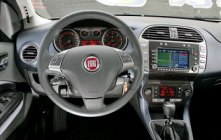 In the
cabin, the dashboard employs more soft-touch plastics and soft padding
at where your eyes usually notice, but below eye level are hard
plastics. Well, Golf also does that to save costs, but its assembly
quality and solidity feels better than the Fiat. Apparently, the
Italian car did not try very hard to match German cars for quality.
Space up front is very good while the multi-adjustable driving position
is excellent, having none of the usual long-arm / short-leg tradition
of Italian cars. At the back, Fiat claims it is the only car capable of
accommodating passengers of 184 cm tall behind passengers of similar
height. However, most journalists found that the rear room is actually
average for both head and leg room. Blame must go to the 2600 mm
wheelbase (unchanged from Stilo) and the coupe-style roof line. On the
up side, the luggage room at 400 liters is easily class-leading. In the
cabin, the dashboard employs more soft-touch plastics and soft padding
at where your eyes usually notice, but below eye level are hard
plastics. Well, Golf also does that to save costs, but its assembly
quality and solidity feels better than the Fiat. Apparently, the
Italian car did not try very hard to match German cars for quality.
Space up front is very good while the multi-adjustable driving position
is excellent, having none of the usual long-arm / short-leg tradition
of Italian cars. At the back, Fiat claims it is the only car capable of
accommodating passengers of 184 cm tall behind passengers of similar
height. However, most journalists found that the rear room is actually
average for both head and leg room. Blame must go to the 2600 mm
wheelbase (unchanged from Stilo) and the coupe-style roof line. On the
up side, the luggage room at 400 liters is easily class-leading.
At launch, there are 3 engines available. The entry level is a 90hp
1.4-liter 16V petrol detuned from Grande Punto. Then there are a couple
of 1.9-liter Multijet turbo diesel, rated at 120hp for 8V and 150hp for
16V. All three are existing engines from Fiat's parts pool. Later this
year will come a new T-JET 1.4-liter turbo petrol, which will produce
120hp and 150hp in different state of tune. To deliver higher mpg and
lower CO2 emission, Fiat is not going to offer bigger capacity petrol
engines to the Bravo.
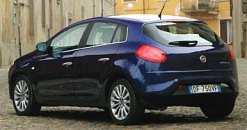 On the
road, the new Bravo is quite impressive for its ride quality. Except on
the worst surfaces, the fine damping and chassis rigidity smoothen out
road irregularities thus return high level of refinement. Way way
better than Stilo. On really broken surfaces, however, it cannot match
the multi-link Focus and Golf. Handling is also noticeably improved
from Stilo. It handles tidily and safely and provides bags of grip. The
brake pedal provides excellent feel. The gearshift is slick and
engaging. The biggest flaw is still the electric power steering.
Although its "parking mode" ease the effort during parking, in regular
mode it is thoroughly lifeless, giving the driver no ideas about the
grip level on the front wheels. For this reason, Bravo cannot be a
driver's car. On the
road, the new Bravo is quite impressive for its ride quality. Except on
the worst surfaces, the fine damping and chassis rigidity smoothen out
road irregularities thus return high level of refinement. Way way
better than Stilo. On really broken surfaces, however, it cannot match
the multi-link Focus and Golf. Handling is also noticeably improved
from Stilo. It handles tidily and safely and provides bags of grip. The
brake pedal provides excellent feel. The gearshift is slick and
engaging. The biggest flaw is still the electric power steering.
Although its "parking mode" ease the effort during parking, in regular
mode it is thoroughly lifeless, giving the driver no ideas about the
grip level on the front wheels. For this reason, Bravo cannot be a
driver's car.
Performance range from poor (for the 1.4 16V) to good (for the 150hp
1.9 turbo diesel). Technically, I am most interested in the new 1.4
petrol turbo. On paper, it provides very good output (150 horsepower)
and tractability (with 152 lbft of torque at just 2000 rpm, plus a
momentary overboost to 170 lbft for overtaking). Its turbo lag is also
negligible. However, on the road it does not feel as strong as
Volkswagen's twin-charger 1.4, let alone the turbo diesels. Without the
turbo diesels' tremendous bottom-end torque, it needs to work hard to
deliver respectable performance. On the contrary, the 150hp 1.9
Multijet diesel is always a solid performer, although it is not as
quiet at higher rev as PSA / Ford's 2.0HDi / 2.0TDCi. It is the pick of
the range.
Overall speaking, Bravo is a fine package and deserve greater success
than Stilo. However, in terms of dynamics and quality it is not up to
the league of Golf, Focus and Astra. Well, you may also say the same to
Grande Punto. So why is it selling so hot ? the key is low price. With
low development and production costs very much in mind, Fiat Bravo is
likely to be significantly cheaper than its European rivals. That
should give it sufficient advantage to make a real presence in the
market. |